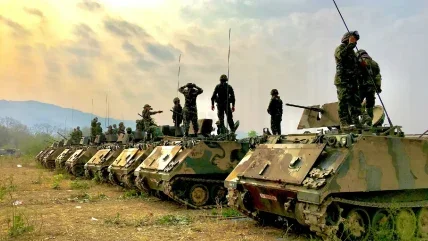
Introduction
Interstate armed conflict poses severe risks to global stability, with far-reaching implications for various sectors, including the finance industry. For Chief Financial Officers (CFOs) and business leaders in Europe, understanding the financial impacts of such conflicts and developing strategies to mitigate associated risks is crucial. This article explores the causes and consequences of interstate armed conflict, its effects on the finance industry, and strategies for managing these challenges.
Understanding Interstate Armed Conflict
Interstate armed conflict refers to military engagements between sovereign states. These conflicts can arise from territorial disputes, resource competition, political disagreements, or historical animosities. Unlike civil wars or internal conflicts, interstate armed conflicts have the potential to disrupt international relations and global economic stability.
Economic Consequences of Interstate Armed Conflict
Interstate armed conflicts have significant economic consequences, affecting trade, investment, and overall economic stability. Key economic impacts include:
- Disruption of Trade: Conflicts between countries can disrupt international trade routes, leading to delays, increased costs, and shortages of essential goods. Sanctions and trade restrictions imposed during conflicts further exacerbate these issues.
- Market Volatility: Armed conflicts create uncertainty in financial markets, leading to increased volatility. Stock markets, foreign exchange rates, and commodity prices often experience sharp fluctuations in response to geopolitical tensions.
- Investment Decline: The risk of conflict deters foreign direct investment (FDI) as investors seek safer markets. Existing investments may also be jeopardised, leading to capital flight and reduced economic growth.
- Inflation and Currency Devaluation: Armed conflicts often lead to inflationary pressures and currency devaluation, particularly in the affected countries. This can erode purchasing power and increase the cost of imports, further straining economies.
Implications for the Finance Industry
The finance industry is particularly vulnerable to the impacts of interstate armed conflict due to its interconnectedness with global economic systems. The following sections examine the implications for financial institutions and the broader finance industry.
Risk Management and Financial Stability
Interstate armed conflicts increase credit, market, and operational risks for financial institutions:
- Credit Risk: Conflicts can impair the ability of businesses and individuals to repay loans, leading to higher default rates and non-performing loans (NPLs). Financial institutions with significant exposure to conflict-affected regions face increased credit risk.
- Market Risk: Geopolitical tensions and armed conflicts contribute to market volatility, affecting asset prices and investment portfolios. Financial institutions must manage these risks through diversification and hedging strategies.
- Operational Risk: Financial institutions operating in conflict zones may face operational disruptions, including damage to physical infrastructure, cybersecurity threats, and disruptions to supply chains.
Impact on Global Financial Markets
Interstate armed conflicts can have profound effects on global financial markets, influencing investor sentiment, asset prices, and capital flows.
- Investor Sentiment: Geopolitical tensions and armed conflicts create uncertainty, leading to risk aversion among investors. This can result in capital flight from riskier assets to safer havens, such as government bonds and gold.
- Asset Prices: Stock prices, foreign exchange rates, and commodity prices are highly sensitive to geopolitical developments. Conflicts in key regions, such as the Middle East or Eastern Europe, can lead to sharp movements in energy prices, impacting global markets.
- Capital Flows: Interstate conflicts can disrupt capital flows, affecting both direct and portfolio investments. Investors may reallocate funds away from conflict-affected regions to minimise risk exposure.
Insurance and Reinsurance
The insurance and reinsurance industries are directly impacted by interstate armed conflicts through increased claims and financial losses. Key challenges include:
- Increased Claims: Conflicts can lead to increased insurance claims related to property damage, business interruption, and political risk. Insurers must assess and price these risks accurately to maintain financial stability.
- Reinsurance Market: Reinsurers, who provide insurance for insurers, face similar challenges. The reinsurance market must adapt to the increasing risk landscape by adjusting pricing models and coverage terms.
Regulatory and Compliance Challenges
Regulatory bodies face significant challenges in addressing the financial impacts of interstate armed conflicts.
- Sanctions Compliance: Financial institutions must navigate complex sanctions regimes imposed during conflicts. Compliance with international sanctions requires robust systems and processes to avoid legal and financial penalties.
- Risk Assessment and Reporting: Regulators require financial institutions to assess and report their exposure to geopolitical risks. This includes stress testing and scenario analysis to evaluate the potential impact of conflicts on financial stability.
Case Studies: Financial Industry Response to Interstate Armed Conflict
Examining past instances of interstate armed conflict provides valuable insights into effective strategies and practices for managing related risks.
1. Russia-Ukraine Conflict (2014-Present)
The ongoing conflict between Russia and Ukraine has had significant financial and economic impacts:
- Sanctions and Trade Restrictions: The conflict led to the imposition of sanctions by Western countries against Russia, disrupting trade and financial transactions. Financial institutions had to implement rigorous compliance measures to adhere to sanctions regimes.
- Market Volatility: The conflict caused significant volatility in global financial markets, particularly in energy and commodity prices. Investors reallocated funds to safer assets, leading to fluctuations in stock and bond markets.
- Credit Risk: Financial institutions with exposure to Russia and Ukraine faced increased credit risk due to economic instability and deteriorating business conditions in the region.
2. Gulf War (1990-1991)
The Gulf War between Iraq and a coalition of countries led by the United States had far-reaching economic and financial consequences:
- Oil Price Shock: The conflict caused a sharp increase in oil prices, leading to global economic disruptions. Financial markets experienced significant volatility, and energy-dependent economies faced inflationary pressures.
- Investment and Trade Disruptions: The war disrupted trade routes and investment flows in the Middle East, affecting global supply chains and economic stability.
- Insurance Claims: The conflict resulted in increased insurance claims related to property damage and business interruption. Insurers had to adjust their risk models and pricing strategies to account for the heightened geopolitical risk.
Outlook and Emerging Trends
Technological Advancements
Technological advancements, such as artificial intelligence (AI) and big data analytics, are transforming risk management and operational resilience in the finance industry.
- AI and Machine Learning: AI and machine learning algorithms can analyse vast amounts of data to identify early warning signs of geopolitical tensions and optimise risk management strategies.
- Cybersecurity: Armed conflicts often involve cyberattacks targeting financial institutions and critical infrastructure. Enhancing cybersecurity measures is crucial to protect against these threats.
Sustainable Finance and ESG Investing
Environmental, Social, and Governance (ESG) investing has gained prominence as investors seek to mitigate geopolitical risks and promote sustainability.
- ESG Criteria: Financial institutions are increasingly incorporating ESG criteria into their investment decisions to identify and manage geopolitical risks. This includes assessing the political stability and governance of countries and regions.
- Sustainable Finance Initiatives: Supporting sustainable finance initiatives can help mitigate the economic impact of armed conflicts. This includes investing in renewable energy, infrastructure, and social development projects.
Policy and Regulatory Developments
Policy and regulatory developments related to geopolitical risk are expected to continue evolving. Financial institutions must stay informed about policy changes and adjust their strategies accordingly.
- International Cooperation: Coordinated policy responses from governments and regulatory bodies are essential to manage the risks associated with interstate armed conflicts effectively.
- Enhanced Risk Management Frameworks: Regulators are likely to strengthen risk management frameworks and stress testing requirements to ensure financial institutions are resilient to geopolitical shocks.
Conclusion
Interstate armed conflicts pose significant challenges and opportunities for the finance industry. CFOs and business leaders in Europe must navigate the complexities of geopolitical risks by understanding their causes and effects, implementing robust risk management strategies, and staying informed about emerging trends and policy developments. By adopting a proactive and comprehensive approach to managing geopolitical risks, financial institutions can protect their financial health, optimise operational efficiency, and support long-term economic stability. The path forward requires vigilance, adaptability, and collaboration. As the global geopolitical landscape continues to evolve, financial institutions must remain agile and responsive to the changing dynamics of interstate armed conflicts. By doing so, they can effectively navigate these challenges and ensure their organisations’ resilience and success in an uncertain world.






